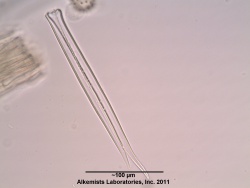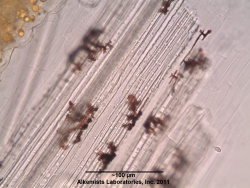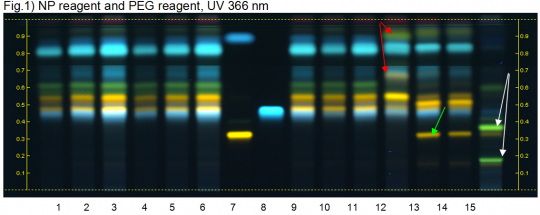Arnica montana (flower)
| Line 15: | Line 15: | ||
=Organoleptic Characteristics= | =Organoleptic Characteristics= | ||
| − | + | {| border=1 | |
| + | | | ||
{{Macroscopy | source=United States Dispensatory (1918) | {{Macroscopy | source=United States Dispensatory (1918) | ||
| description="The whole [''Arnica montana''] plant, when fresh, has a strong, disagreeable odor, which is apt to excite sneezing, and is diminished by drying. The taste is acrid, bitterish, and durable. | | description="The whole [''Arnica montana''] plant, when fresh, has a strong, disagreeable odor, which is apt to excite sneezing, and is diminished by drying. The taste is acrid, bitterish, and durable. | ||
| Line 24: | Line 25: | ||
"[Rhizome's odor] somewhat aromatic; taste ungently aromatic and bitter."}} | "[Rhizome's odor] somewhat aromatic; taste ungently aromatic and bitter."}} | ||
| − | + | |} | |
=Macroscopic Characteristics= | =Macroscopic Characteristics= | ||
| − | + | {| border=1 | |
| + | | | ||
{{Macroscopy | source=United States Dispensatory (1918) | {{Macroscopy | source=United States Dispensatory (1918) | ||
| − | | description=''Arnica montana'' is a perennial herbaceous plant, | + | | description=''Arnica montana'' is a perennial herbaceous plant, having a woody, brownish, horizontal rhizome, from 2 to 10 cm. long, and 0.5 to 5 mm. thick, ending abruptly, and sending forth numerous slender fibers of the same color. The stem is about 3 dm. high, cylindrical, striated, hairy, and terminating in one, two, or three peduncles, each bearing a flower. The radical leaves are ovate, entire, ciliated, and obtuse; those of the stem, which usually consist of two opposite pairs, are lance-shaped. Both are bright green, and somewhat pubescent on their upper surface. The flowers are yellow. |
| − | having a woody, brownish, horizontal rhizome, from 2 to 10 cm. long, and 0.5 to 5 mm. thick, ending abruptly, and sending forth numerous slender fibers of the same color. The stem is about 3 dm. high, cylindrical, striated, hairy, and terminating in one, two, or three peduncles, each bearing a flower. The radical leaves are ovate, entire, ciliated, and obtuse; those of the stem, which usually consist of two opposite pairs, are lance-shaped. Both are bright green, and somewhat pubescent on their upper surface. The flowers are yellow. | + | |
The U. S. Pharmacopoeia thus describes the flowers: "Consisting chiefly of the tubular and ligulate flowers, occasionally with the involucre and receptacle present; involucral bracts narrowly lanceolate, about 1 cm. in length, dark green and pubescent; receptacle slightly convex, deeply pitted and densely short-hairy; ray flowers bright yellow, the ligulate portion 2 cm. in length, more or less folded lengthwise, 3-toothed, 7- to 12-veined, pistillate; tubular flowers perfect, reddish-yellow, stamens without a tail-like appendage (distinguished from anthers in flowers of ''Inula Helenium'' Linne, which have two bristles or long tails at the base); the achenes spindle-shaped, from 5 to 7 mm. in length, dark brown, finely striate, glandular-pubescent and surmounted by a pappus a little longer than the achene and composed of a single circle of nearly white barbellate bristles [...] The powder is yellowish-brown; pollen grains numerous, from 0.025 to 0.035 mm. in diameter, spherical, triangular in section and spinose; non-glandular hairs of three kinds, either unicellular, 4- to 6- celled, or consisting of a pair of unicellular hairs with numerous pores on the dividing wall; glandular hairs of three kinds, either with a large unicellular stalk and a unicellular, glandular head, or with a 4-celled stalk and a unicellular, glandular head, or a stalk of a double row of 5 cells and a 2-celled, glandular head; pappus consisting of a multicellular axis with unicellular branches." U.S. | The U. S. Pharmacopoeia thus describes the flowers: "Consisting chiefly of the tubular and ligulate flowers, occasionally with the involucre and receptacle present; involucral bracts narrowly lanceolate, about 1 cm. in length, dark green and pubescent; receptacle slightly convex, deeply pitted and densely short-hairy; ray flowers bright yellow, the ligulate portion 2 cm. in length, more or less folded lengthwise, 3-toothed, 7- to 12-veined, pistillate; tubular flowers perfect, reddish-yellow, stamens without a tail-like appendage (distinguished from anthers in flowers of ''Inula Helenium'' Linne, which have two bristles or long tails at the base); the achenes spindle-shaped, from 5 to 7 mm. in length, dark brown, finely striate, glandular-pubescent and surmounted by a pappus a little longer than the achene and composed of a single circle of nearly white barbellate bristles [...] The powder is yellowish-brown; pollen grains numerous, from 0.025 to 0.035 mm. in diameter, spherical, triangular in section and spinose; non-glandular hairs of three kinds, either unicellular, 4- to 6- celled, or consisting of a pair of unicellular hairs with numerous pores on the dividing wall; glandular hairs of three kinds, either with a large unicellular stalk and a unicellular, glandular head, or with a 4-celled stalk and a unicellular, glandular head, or a stalk of a double row of 5 cells and a 2-celled, glandular head; pappus consisting of a multicellular axis with unicellular branches." U.S. | ||
| Line 38: | Line 39: | ||
}} | }} | ||
| + | |} | ||
=Microscopic Characteristics= | =Microscopic Characteristics= | ||
| − | {{Microscopy | source=Elan M. Sudberg, Alkemist Laboratories | + | {{Media2 |cat=Microscopy | source=Elan M. Sudberg, Alkemist Laboratories |
| companyimage= AP-LOGO-Laboratories Crop - Copy.jpg | | companyimage= AP-LOGO-Laboratories Crop - Copy.jpg | ||
| − | | companyURL=http://www. | + | | companyURL=http://www.alkemist.com |
| mainimage= Arnica_montana_-_Alkemist_Laboratories.jpg | | mainimage= Arnica_montana_-_Alkemist_Laboratories.jpg | ||
| caption1=Paired trichome observed at 400x with Acidified Chloral Hydrate Glycerol Solution. | | caption1=Paired trichome observed at 400x with Acidified Chloral Hydrate Glycerol Solution. | ||
| − | | | + | | source2=Elan M. Sudberg, Alkemist Laboratories |
| + | | companyimage2= AP-LOGO-Laboratories Crop - Copy.jpg | ||
| + | | companyURL2=http://www.alkemist.com | ||
| image2= Arnica_montana-1_-_Alkemist_Laboratories.jpg | | image2= Arnica_montana-1_-_Alkemist_Laboratories.jpg | ||
| caption2=Phytomelan deposits in the fruit wall observed at 400x with Acidified Chloral Hydrate Glycerol Solution. | | caption2=Phytomelan deposits in the fruit wall observed at 400x with Acidified Chloral Hydrate Glycerol Solution. | ||
Revision as of 22:35, 16 March 2014
Contents |
Nomenclature
Arnica montana L. Asteraceae
Standardized common name (English): arnica
Botanical Voucher Specimen
Organoleptic Characteristics
|
Macroscopic Characteristics
|
Microscopic Characteristics
 |
 |
|
|
|
High Performance Thin Layer Chromatographic Identification
|
Arnica (flower) (Arnica montana) Lane Assignments Lanes, from left to right (Track, Volume, Sample):
Reference Sample(s) Reference: Dissolve 2 mg of caffeic acid, 3.5 mg of rutin and 2.5 mg of chlorogenic acid individually in 5 mL of methanol. Stationary Phase Stationary phase, i.e. Silica gel 60, F254 Mobile Phase Ethyl acetate, formic acid 98%, water, ethyl methyl ketone 50:10:10:30 (v/v/v/v) Sample Preparation Method Sample: Mix 1 g of powdered sample with 10 mL of methanol and sonicate for 10 minutes, then centrifuge or filter the solutions and use the supernatants / filtrates as test solutions. Derivatization reagent: 1.) NP reagent Preparation: 1 g of natural products reagent in 200 mL ethyl acetate 2.) PEG reagent Preparation: 10 g of polyethylene glycol 400 in 200 mL methylene chloride Use: Heat plate for 3 min at 100°C, dip (time 0, speed 5) in NP reagent while still hot, dry and dip (time 0, speed 5) in PEG reagent Detection Method Saturated chamber; Developing distance 70 mm from lower edge; Relative humidity 33% Other Notes Images presented in this entry are examples and are not intended to be used as basis for setting specifications for quality control purposes. System suitability test: Rutin: orange fluorescent zone at Rf ~ 0.32; chlorogenic acid: bluish fluorescent zone at Rf ~ 0.46; caffeic acid: bluish fluorescent zone at Rf ~ 0.89 Identification: Compare result under UV 366 nm with reference images. The fingerprint of the test solution is similar to that of the corresponding botanical reference sample. Additional weak zones may be present. The chromatogram of the test solution shows a blue-white zone corresponding to chlorogenic acid. There are two yellow zones and a green zone above the reference material chlorogenic acid. At the upper part of the chromatogram there are one to two blue-white zones. Below the NOTE: No prominent zone is seen at or below the position of rutin. Test for adulteration: No greenish fluorescent zone is seen at or just above the position of caffeic acid and no yellow fluorescent zone is seen at Rf ~ 0.65 (red arrows; Chamisso arnica (flower)). No yellow zone is seen at the position of rutin (green arrow; False arnica flower). No green zone is seen below or just above the position of rutin (white arrows; Calendula flower).
|
Supplementary Information
Sources
- ↑ United States Dispensatory (1918)
- ↑ United States Dispensatory (1918)
- ↑ Elan M. Sudberg, Alkemist Laboratories http://www.alkemist.com
- ↑ Elan M. Sudberg, Alkemist Laboratories http://www.alkemist.com
- ↑ HPTLC Association http://www.hptlc-association.org/


